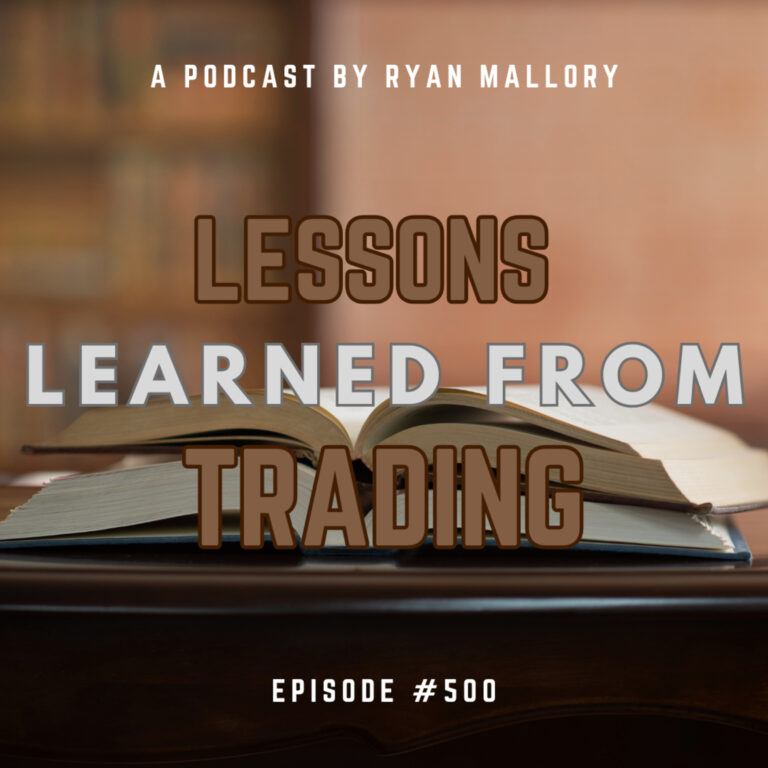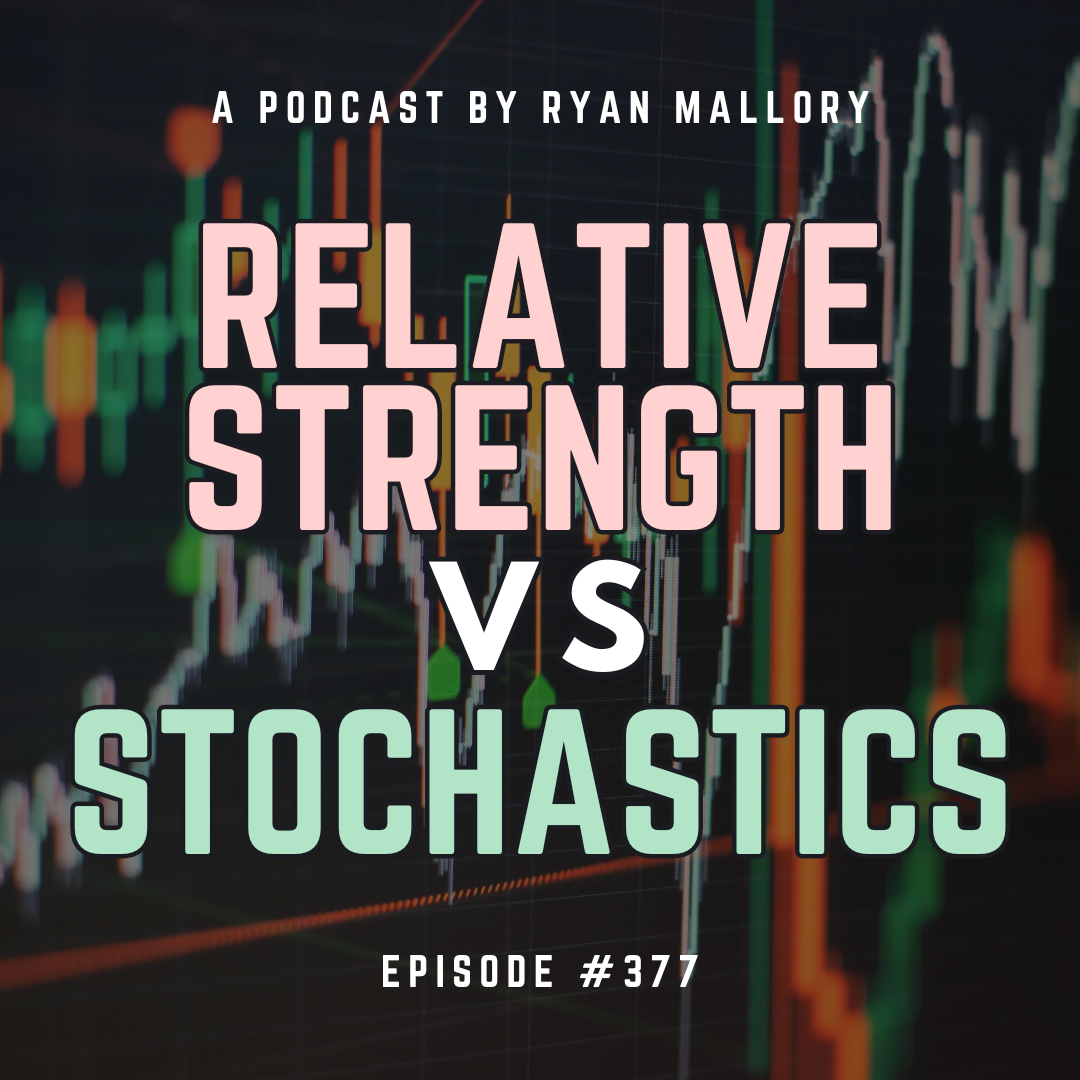Episode Overview
What are the benefits, differences and similarities to using RSI (Relative Strength Indicator) and the Stochastics Indicator? In this episode Ryan Mallory discusses how he uses these two indicators, what they are and how they can be used in one’s swing trading.
Available on: Apple Podcasts | Spotify | Amazon | YouTube
Episode Highlights & Timestamps
- [0:07] Introduction
Ryan introduces the podcast and sets the tone for a practical discussion on technical indicators. - [0:45] Listener Question Sparks the Topic
A Trading Block member asks about the difference between RSI and Stochastics, inspiring the deep dive. - [2:56] Understanding RSI
Ryan breaks down what the Relative Strength Index is, how it’s calculated, and how he uses it. - [5:49] Understanding Stochastics
Explains how Stochastics works, including %K and %D lines, and how it compares to RSI. - [9:50] How to Use RSI and Stochastics Together
Why combining the two can improve signal confirmation and why price and volume still reign supreme.
Key Takeaways from This Episode:
- Know the Core Difference: RSI compares recent gains to losses, while Stochastics compares the closing price to the overall range. They serve different purposes despite both being momentum oscillators.
- Timeframe Matters: RSI is typically better for spotting longer-term trends. Stochastics moves faster but often gives more frequent and less reliable reversal signals.
- Understand the Thresholds: RSI identifies overbought at 70 and oversold at 30. Stochastics uses 80 and 20, and it’s easier for it to hit extreme readings like 90 or 10.
- Don’t Trade in Isolation: These indicators should not be used alone. Always cross-reference signals with price action and volume before making a decision.
- Curb Emotional Trading: Both tools can help you recognize when you’re acting out of FOMO. If RSI and Stochastics are both flashing extreme readings, it’s likely a sign to wait.
Resources & Links Mentioned:
- Swing Trading the Stock Market – Daily market analysis, trade setups, and insights by Ryan Mallory.
- Join the SharePlanner Trading Block – Get real-time trade alerts and community support.

Take the Next Step:
✅ Stay Connected: Subscribe to Ryan’s newsletter to get free access to Ryan’s Swing Trading Resource Library, along with receiving actionable swing trading strategies and risk management tips delivered straight to your inbox.
📈 Level Up Your Trading: Ready for structured training? Enroll in Ryan’s Swing Trading Mastery Course, The Self-Made Trader, and get the complete trading course, from the foundational elements of trading to advanced setups and profitable strategies.
📲 Join the Trading Community: Sign up for SharePlanner’s Trading Block to become part of Ryan’s swing-trading community, which includes all of Ryan’s real-time swing trades and live market analysis.
Full Episode Transcript
Click here to read the full transcript
0:07
Hey, I’m Ryan Mallory and this is my Swing Trading the Stock Market podcast. I’m here to teach you how to trade in a complex, ever changing world of finance.
0:16
Learn what it means to trade profitably and consistently, managing risk, avoiding the pitfalls of trading, and most importantly, to let those winners run wild.
0:25
You can succeed at the stock market, and I’m ready to show you how. Hey everybody, this is Ryan Mallory with Swing Trading the Stock Market.
0:33
In today’s episode, we’re going to talk about relative strength indicator versus the stochastics indicator.
0:39
How do I use them in my trading? How important are they for traders to be aware of, to be knowledgeable of?
0:46
We’re going to talk about all of that now. This comes from a person who in the trading block asked me a question today about these two things and he wrote. I’ve got a silly question to ask and we’d love for you to do a video on it if you’re able to find the time, but would it be possible to spend time on RSI and Stochastics? I’m sorry if this is a very green question for other people, but for me I’ve always wanted to ask this for a long time. No rush.
1:11
Well, I’m getting it done the same day that you asked it, so I guess maybe I’m rushing it a little bit. He did ask for a video, but I think this is something that I can’t explain in a podcast as well. And my goal here, as it is with every podcast and I think there’s a lot of podcasts out there that they get into all the chart details. Like you have the chart in front of you while you’re driving down the road listening to the podcast.
1:35
One thing I always try to do, and it’s one of the reasons too, why I focus so much on the psychology, because you don’t need a chart in front of you to focus on that. But in something like this where it can get a little bit more technical, I wanna keep it very understandable to where you don’t need to pull up a chart to where what you learned here today, you’ll remember it, you’ll go and look at a chart. It’s like, OK, that’s what it was talking about.
1:56
And like I said, my point here is to keep this simple and without the need of visual aids. So we’re talking about RSI and stochastics, both important indicators.
2:07
Actually, you call these oscillators important oscillators for traders on a day-to-day basis. I use both of them and I don’t rely on them as much as I rely on price and volume.
2:17
Those are the two things, two elements that I rely on the most. I think those are the most important parts of trading price followed by volume.
2:25
And then you get the indicators and the oscillators and those are really subsets of price and volume.
2:30
They’re derivatives of price and volume. So it pays to be good at just understanding price and volume and then, you know, start incorporating RSI or MACD or stochastics into your trading to to give you a better edge.
2:41
But you don’t necessarily need these in order to have an edge.
2:51
But they can’t help. So for those who don’t know, RSI, that’s a relative strength index.
2:56
It measures the speed and the change of price movements. Stock or an index or an ETF can even be crypto or forex, whatever you’re trading.
3:05
Essentially this is going to measure that speed and the change of price movements. It’s calculated using average gains and losses over a specific period of time.
3:13
For me, I use a 14 day setting. Some people will increase that.
3:17
Some people want a faster RSI and so they’ll decrease that to maybe five or six days. Generally most people use 14 days.
3:23
Here RSI levels to be aware of would be below 30 is going to indicate an oversold market. So when you see RSI dip below, it means that the market is getting very oversold above 70.
3:36
You would consider that a very overbought market. So you look at the market right now, the S&P 500 over the last three weeks it has gone absolutely
3:44
bonkers and during that time it’s gone from being below 30 all the way up to 91 and that’s like one of the strongest readings we’ve had in two or three years.
3:53
So it’s a historically high RSI reading to get to that level. So that makes it very overbought.
3:58
And what a lot of people will do is they’ll take whatever stock that they’re trading or looking to trade, and if the stock dips below 30, they’ll consider that a potential buy signal.
4:08
They’ll see it as being undervalued. They need to go ahead and get long.
4:11
It’s oversold. But I’m not a huge fan of that.
4:14
Because you’ve heard me talk about the falling knife theory, right? You see a stock falling hard.
4:20
Yeah, it might be below 30 on the RSI, it may even be below 10 at some point. But if it’s still falling, let it keep falling.
4:27
There’s no need to try to catch it. And that goes back to, like I said, the falling knife.
4:31
If you try to catch a falling knife, what happens? Often times you might find yourself trying to catch it by the blades and not the handles.
4:37
And that’s a problem. If you start catching knives that are falling and you catch it by the blade, you’re going to get cut up, you’re going to get beaten up, and you’re not going to like it.
4:44
It’s going to hurt. And it’s just like that with a stock, a stock in the free, in a free fall, you try to catch it, you know, on the way down and try to time that bottom.
4:50
It’s going to be equivalent to trying to catch a falling knife. And the laws of gravity suggests that the longer it falls, the more acceleration there is to that
4:58
falling. So you know, the faster it follows makes it even harder to catch, and I think the same can apply to trading.
5:04
So what I’d like to do is I’d like to wait for it to cross back up above 30 because it can spend a lot of time below 30.
5:09
Just because it hits 30 doesn’t mean it’s just going right back up again.
5:13
It’s been a lot of time. So if I’m gonna use the RSI, I’m more than likely to wait for that line to dip below 30.
5:19
And remember that because I didn’t explain this, the minimum or the lowest that it can go is 0, The highest it can go is 100.
5:25
So like I said, 30 oversold, 70 overbought. So if it dips below 30, that’s not an automatic buy signal in my book.
5:32
What I’m waiting for it to do is, you know, spend whatever amount of time it needs to an oversold territory and then curve back up above 30, close above 30 and then we’re talking business.
5:41
Then that becomes a trade that might be ready to turn the corner and fade back to the upside. Now on the stochastics, what are we dealing with here?
5:49
This is going to help identify momentum and potential trend reversals as well, Very similar, and it’s in many ways to the RSI app.
5:57
I consider stochastics to be a little bit faster with more reversals than what the RSI provides. Now this is gonna consist of two lines.
6:04
This is gonna have this percentage K, that’s your fast line and a percentage D, that’s your slow line.
6:08
And they’re gonna be showing the closing price relative to the high low range over a certain period of time.
6:13
So the levels to be aware of, we talked about RSI being 30 and 70, it’s gonna be on a scale of zero to 100.
6:19
On the stochastics though, yes, it’s still zero to 100, but it’s gonna be oversold at 20, overbought at 80.
6:26
And I think it’s a lot easier for stochastics to get to like 9095 even like 99 than it is for RSII mean, like I said, RSI is hitting 91 right now in the S&P 500 and that’s a historically high reading
6:38
and what a lot of people will do, they’ll use the crossover of the percentage K and the percentage D lines as a crossover for entry or exit point.
6:45
So if you get a crossover to the upside when it’s oversold, then that people will use that as a buy entry and if you get a crossover up top when it’s over 80, they’ll consider that a entry to a short
6:58
position or to close out a trade. Now like I said, there is some similarities between the two.
7:04
Both are momentum oscillators used to predict potential market reversals. They help traders identify oversold and overbought market environments and they’re useful in
7:13
signaling potential trend reversals, whether it be swing trading, long term trading. Now when it comes to intraday trading, if you’re like trying to day trade, yes there’s sometimes
7:24
uses that you can use stochastics on, but I don’t think it’s as relevant in intraday trading as the RSI.
7:29
I think the RSI is still relevant in intraday the stochastics can be pretty wild and the signaling, even with the crossovers on the percentage K and the percentage D, they’re not as reliable.
7:40
They can be helpful to perhaps booking some profits or closing out a position, but trying to base entries on them, I don’t think they’re that great.
7:47
Now the differences between the RSI and the Stochastics. And before I get into them, I wanna tell you real quickly about swingtradingthestockmarket.com.
7:55
This is my Patreon service that goes alongside of this podcast. With it, you’re going to get all my stock market research each and every day.
8:02
That’s going to include videos on the S&P 500, the Russell 2000, the NASDAQ 100, the VIX. You’re gonna get all that good stuff.
8:09
You’re also gonna get big tech updates throughout the week, and you’re gonna get daily watch lists from me about the stocks that I’m looking at each day.
8:16
And then I also review them. How cool is that, right?
8:18
A lot of people just throw watch lists out there, but they don’t ever review how to have traded them or what went right or what were wrong.
8:24
I do that. So check it out.
8:26
swingtradingthestockmarket.com. I think you’ll really like it.
8:28
OK, so back to the differences between the RSI and Stochastic.
8:35
There’s a lot of similarities in terms of how it measures overbought and oversold. RSI, though focuses on the magnitude of recent gains versus the losses.
8:43
Now the Stochastics will compare the closing price to the price range.
8:52
On the flip side, RSI is going to focus on the magnitude of the recent gains versus the magnitude of the recent losses, and when that magnitude is much greater than the recent gains, it’s going to
9:03
climb and vice versa. Now, on the whole, I would say that RSI is usually more preferred for identifying longer term
9:10
trends, and while some say the stochastics is useful for identifying short term trends, like in intraday trading, I don’t think that those trends are as reliable.
9:19
I still prefer to use stochastics on a daily chart just to see how overbought or oversold it is. If I’m getting readings of 9798, I’m probably not gonna touch a stock or an ETF that’s that
9:30
overbought to the long side. And if it’s like at one or two on the stochastics, I’m not gonna be looking at getting short.
9:35
But that’s all off of the daily chart. I also like to look at it from the weekly and monthly charts as well.
9:40
And if I’m seeing continuous trends on all those different indicators suggesting a very overbought market or a very overbought stock, I’ll hold off on trying to get to the long side on it.
9:50
Now, a lot of folks will actually try to use both of these indicators together to confirm better signals for getting long or getting short.
9:58
That’s fine to do. I don’t think there’s anything wrong again.
10:00
I think because these are derivatives of price and volume, I think it’s more important that you become an expert at understanding price and volume and its rawest sense using candles.
10:10
Understand price and volume in that way. And then when you apply a RSI and stochastics, it won’t be as important part of your trading, but it will still be helpful and you have to be smart about it.
10:17
You have to like, for instance, if you’re using RSI Reversal Central Day and you’re using it on the NASDAQ 100 and you see Apple and Amazon and Microsoft, they’re just ripping to the upside, OK, well, you know, for instance, Apple, Amazon and Microsoft, they’re going to be a huge, let’s throw in
10:39
Google for just kicks and giggles. They’re gonna have a huge impact on the NASDAQ 100.
10:43
And if they’re not pulling back at all, but you have a very overbought RSI reading, let’s say it’s at 92 and it crosses back down into 70, that’s probably not a good one to get short on because if the big tech stocks are holding up, why would you want to get short on the NASDAQ 100 where the influence of the big tech stocks is so heavy, it’s more than likely going to be a false signal.
11:02
So it’s important to consider some other factors and not just trade off of these indicators and isolation.
11:08
Overall though, I mean, I think they’re great tools. I think that you can learn a lot from using them and you’re trading.
11:13
It can help you to not get too FOMO D up. I think that’s probably one of the really good things about these indicators, particularly like the the RSI and the stochastics that we’ve been talking about, is that it can help you to identify whether if you’re really desperate about getting into a trade and you’re looking at a stochastics
11:31
and RSI and both of them are over 90, you might be trying to FOMO your way into a trade. Which would suggest that your reasoning or your rationale for getting into the trade is not that great.
11:40
So that would be perhaps a big red flag for maybe I should not be getting into this trade at this particular time.
11:46
So in general, as we wrap up this podcast, RSI Stochastics, useful Tools still rely more on price and volume.
11:54
Those two things remain the best aspects of chart reading that you can be the master of.
12:01
And then when you become really good at those, yeah, Stochastics, RSI, they have their place in trading would be good at price.
12:07
Some point, if you enjoyed this podcast episode, I would encourage you to leave me a five star review.
12:11
Those really do help out a lot. I say it on every episode, but I really do mean it.
12:14
I really appreciate your feedback. It helps me to continue to grow this podcast.
12:18
Been doing it now for gosh, I think like six years. I’m coming up on my 400th episode here probably in early 2024.
12:25
So I’m excited about that and I don’t think a lot of people get to their 400th episode, but through y’all support and encouragement, I’ve been able to do that.
12:32
So I really do appreciate it. And keep sending me your questions. ryan@shareplanner.com.
12:36
I honestly, I don’t get enough from you guys, so keep sending me your questions. Keep sending me your stories.
12:41
I really love hearing your stories. I love hearing about your failures.
12:44
I love hearing well, let me preface that I don’t necessarily love hearing about the failures, but I need to hear about your failures because it helps me to better understand you when I’m doing these
12:52
podcast episodes. So include your failures.
12:54
I do love hearing about your successes. Those are exciting so include those as well and check out Swing Trading the-stockmarket.com.
13:01
Thank you guys and God bless. Thanks for listening to my podcast Swing Trading the Stock Market.
13:07
I’d like to encourage you to join me in the SharePoint or trading block where I navigate the stock market each day with traders from around the world.
13:15
With your membership you will get a seven day trial and access to my trading room including alerts via text, e-mail and WhatsApp.
13:22
So go ahead, sign up by going to shareplanner.com/trading Block, that’s www.shareplanner.com/trading-block and follow me on SharePlanners, Twitter, Instagram and Facebook where I provide unique market
13:35
and trading information every day. If you have any questions, please feel free to e-mail me at ryan@shareplanner.com.
13:42
All the best to you and I look forward to trading with you soon.
Enjoy this episode? Please leave a 5-star review and share your feedback! It helps others find the podcast and enables Ryan to produce more content that benefits the trading community.
Have a question or story to share? Email Ryan and your experience could be featured in an upcoming episode!
Become part of the Trading Block and get my trades, and learn how I manage them for consistent profits. With your subscription you will get my real-time trade setups via Discord and email, as well as become part of an incredibly helpful and knowledgeable community of traders to grow and learn with. If you’re not sure it is for you, don’t worry, because you get a Free 7-Day Trial. So Sign Up Today!

Welcome to Swing Trading the Stock Market Podcast!
I want you to become a better trader, and you know what? You absolutely can!
Commit these three rules to memory and to your trading:
#1: Manage the RISK ALWAYS!
#2: Keep the Losses Small
#3: Do #1 & #2 and the profits will take care of themselves.
That’s right, successful swing-trading is about managing the risk, and with Swing Trading the Stock Market podcast, I encourage you to email me (ryan@shareplanner.com) your questions, and there’s a good chance I’ll make a future podcast out of your stock market related question.
In today's episode, at episode 500, I am diving into the lessons learned from trading over the last 100 episodes, because as traders we are evolving and always attempting to improve our skillset. So here is to episode 500, and to another 500 episodes of learning and developing as swing traders in the stock market!
Be sure to check out my Swing-Trading offering through SharePlanner that goes hand-in-hand with my podcast, offering all of the research, charts and technical analysis on the stock market and individual stocks, not to mention my personal watch-lists, reviews and regular updates on the most popular stocks, including the all-important big tech stocks. Check it out now at: https://www.shareplanner.com/premium-plans
📈 START SWING-TRADING WITH ME! 📈
Click here to subscribe: https://shareplanner.com/tradingblock
— — — — — — — — —
💻 STOCK MARKET TRAINING COURSES 💻
Click here for all of my training courses: https://www.shareplanner.com/trading-academy
– The A-Z of the Self-Made Trader –https://www.shareplanner.com/the-a-z-of-the-self-made-trader
– The Winning Watch-List — https://www.shareplanner.com/winning-watchlist
– Patterns to Profits — https://www.shareplanner.com/patterns-to-profits
– Get 1-on-1 Coaching — https://www.shareplanner.com/coaching
— — — — — — — — —
❤️ SUBSCRIBE TO MY YOUTUBE CHANNEL 📺
Click here to subscribe: https://www.youtube.com/shareplanner?sub_confirmation=1
🎧 LISTEN TO MY PODCAST 🎵
Click here to listen to my podcast: https://open.spotify.com/show/5Nn7MhTB9HJSyQ0C6bMKXI
— — — — — — — — —
💰 FREE RESOURCES 💰
— — — — — — — — —
🛠 TOOLS OF THE TRADE 🛠
Software I use (TC2000): https://bit.ly/2HBdnBm
— — — — — — — — —
📱 FOLLOW SHAREPLANNER ON SOCIAL MEDIA 📱
*Disclaimer: Ryan Mallory is not a financial adviser and this podcast is for entertainment purposes only. Consult your financial adviser before making any decisions.





